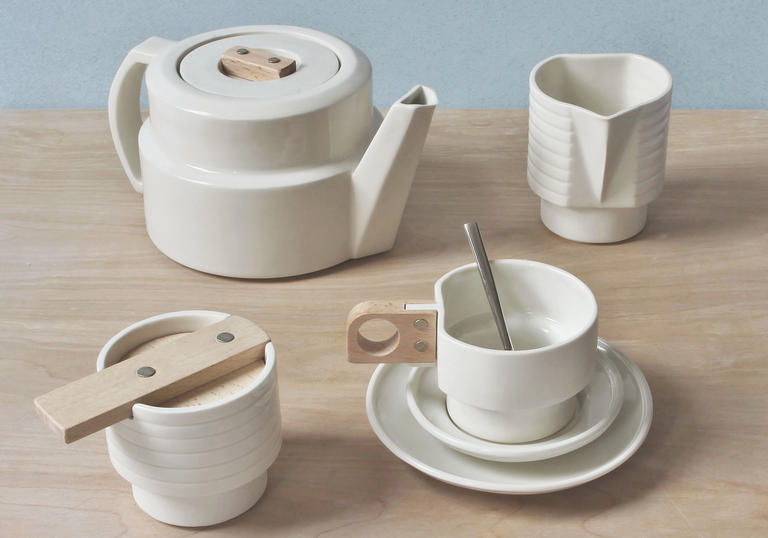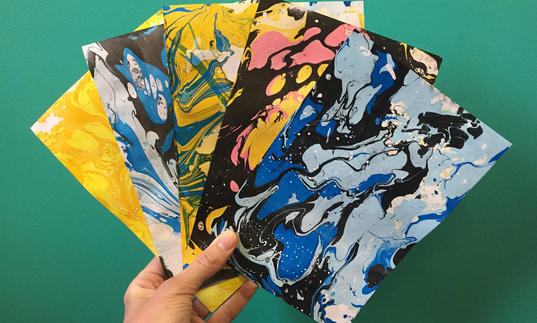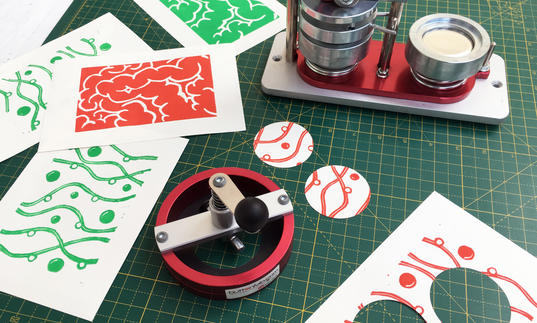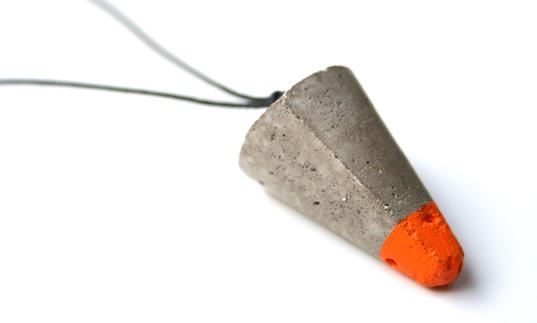Brighton-based ceramicist and designer Emma Johnson is the latest maker to be showcased in the Barbican Shop as part of our Makers initiative. Through porcelain and beech, her work celebrates the once called ‘monstrous’ Brutalist architecture, creating minimal and playful designs.
We catch up with Emma to find out more about her work and her Barbican range.
How did you get into ceramics?
Before university I didn’t have many opportunities to work with clay, but I’d always enjoyed practical lessons at school, like design technology and art. In our course we had a chance to try different material areas (wood, metal, polymers/ composites, and ceramics) and I was drawn to ceramics straight away; particularly slipcasting and mould making. Since graduating I’ve stayed in Brighton and now work from a shared studio with some friends from university. I’ve just finished the Hothouse scheme, an intensive business development programme for emerging makers run by the Crafts Council, and this has really helped me to consider the business side of my practice as well as the making side.
‘Ceramics can have a mind of its own, so I can’t always predict whether a form will be successful’
Your work is heavily influenced by cityscapes and architectural details, could you tell us more about this please?
I’m automatically drawn to the precision of architectural forms, and really love the challenge of trying to replicate these in ceramics. Although I like surface decoration on other peoples work, it’s not my strength; I’m a lot more interested in exploring form in my work. That’s partly why I became so interested in Brutalism; the lack of adornment along with the strong and sculptural forms fit my interests perfectly.
I think of my work as being a kind of interchangeable miniature architecture, which users can ‘build’ through stacking. I also look to architecture for interesting ways to combine materials.
How did you incorporate classic Brutalist aesthetics into your designs?
When designing the Atro-city range, I wanted the pieces to convey a balance between typical Brutalist aesthetics and the design notions which lie in the architecture. To study the aesthetic elements, I’ve taken lots of trips to photograph Brutalist buildings, mainly around London. My work looks at the changing opinions surrounding Brutalist architecture over the years (hence the name ‘Atro-city’, as a bit of a pun on how what was once seen as ‘atrocious’ by many is now being seen in a new light), so I prefer to use my film camera as it captures the architecture in a much softer way.
Rather than trying to recreate the look of concrete, I chose to work in porcelain and beech, as I felt the clean simplicity of these materials allows the sharp and rigid forms to be the main focus. The porcelain has been stained throughout rather than covered with a coloured glaze, and the rivets used to attach the beech to the porcelain are celebrated rather than hidden away.
Something which I think makes good design is timelessness
Ceramics is a long process, can you talk to us about your creative process?
To make my pieces I work with slipcasting and mould-making techniques, and this basically involves pouring liquid clay into a plaster mould, which then absorbs some of the liquid from the clay to create a wall. You then pour the excess liquid out of the mould, and are left with a form in the shape of the plaster mould interior. This technique is perfect because it allows me to create multiples of the precise and angular forms I’m most interested in. I make the forms for the moulds on a plaster lathe to create the sharp and defined edges, and hand carve the initial forms for handles and spouts from plaster.
Compared to some other ceramic production techniques, mould-making is not as practical for experimentation, so I prefer to spend time on drawings followed by to-scale paper models to help me predict any issues which might arise. Ceramics can have a mind of its own, so I can’t always predict whether a form will be successful, but at least this way I can figure out any obvious problems without having to wait weeks for it to come through all the firings.
You can’t really rush ceramics so it’s just a case of being patient and waiting until the clay is at the right stage to work with
What does a typical day (if there is one…!) look like in your studio
Usually things start off relatively calm; I’ll get the moulds out, mix up some slip if I need to, and start casting. Then I decide to start another job to keep me busy after the first pieces have been poured. Sometimes I can be quite optimistic about what I can get done in the day, so can end up in the studio a bit later than planned! You can’t really rush ceramics so it’s just a case of being patient and waiting until the clay is at the right stage to work with.
There is always a debate about good design and functionality. What’s your relationship to them?
I think that to design something which will function well for everybody is a huge challenge. When designing my pieces, I referred to Robin Hopper’s book Functional Pottery: Form and Aesthetic in Pots of Purpose to research exactly which design details would enhance the function of each piece, and which were unnecessary. I balanced the advice from this book along with my own functional requirements, such as wanting all of the pieces to be able to stack together, as well as other elements from Brutalist aesthetics.
Something which I think makes good design is timelessness. If an object can surpass trends and fashions and come into a new era still looking modern, then I think it is a good design. I’m hoping that the simple forms, honest use of materials and mid-century inspired colour palette I’ve chosen to work with will age well – I’ll have to see in a few years how the pieces have fared!
Do you have any advice for aspiring ceramicists?
I would say to just have lots of patience. Ceramics can be such hard work, and that teamed with the rollercoaster of self-employment can feel a bit overwhelming at times. But when all of the hard work pays off and you open a good kiln it makes it all worth it. To make a career in ceramics you have to be really smart about balancing time making in the studio alongside time focusing on the business side of things.
Browse Emma Johnson’s collection for the Barbican Shop
You can find Emma on Instagram @emmajohnsonceramics and visit her website: emmajohnsonceramics.com




